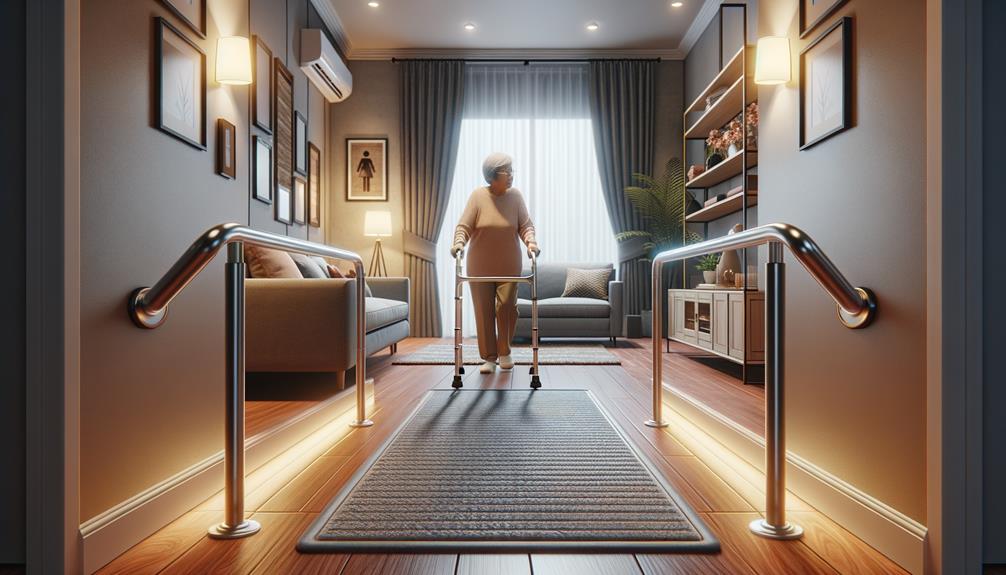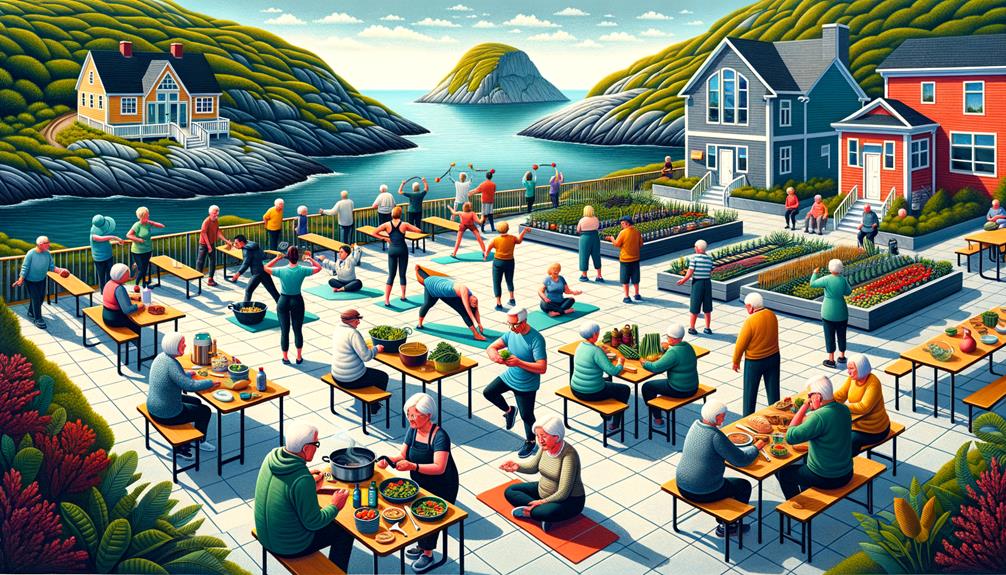Proactively preventing falls among seniors involves implementing essential home safety modifications. Ensure good lighting throughout the home and install grab bars in bathrooms and near stairs. Remove tripping hazards like loose rugs and clutter, and use non-slip mats in wet areas. Keeping frequently used items within easy reach and optimizing living spaces for easy navigation are key. Regularly evaluating the home environment and encouraging physical activity to improve strength and balance are also crucial. By making these changes, we can create a safer environment for seniors.
Assessing Home Hazards
Identifying potential fall hazards in the home is crucial for seniors’ safety. Loose rugs, cluttered pathways, and poor lighting can lead to serious injuries and hospitalizations. To address this, we need to thoroughly evaluate areas where these risks are present.
Falls are a significant concern, and by using home assessment tools and checklists, we can systematically examine the living environment to understand the impact of home hazards on older adults.
When analyzing areas of the home, we should consider where supportive features like grab bars and handrails could be installed to reduce fall risk. These features provide additional stability, making everyday activities safer for seniors. Home modifications based on these evaluations are vital. For example, securing loose rugs or improving lighting in dim areas can substantially lower the risk of falls.
Enhancing Bathroom Safety
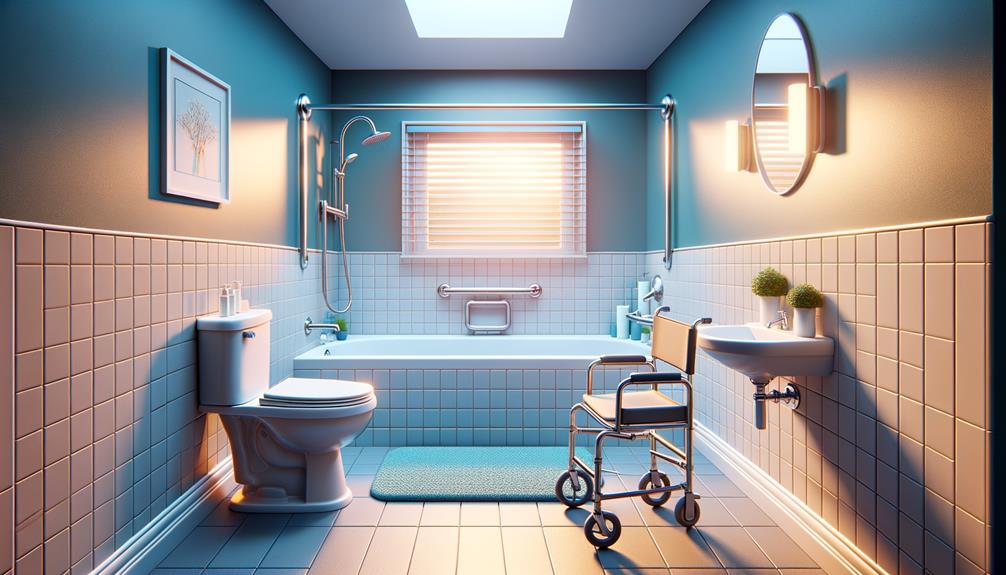
Enhancing Bathroom Safety for Seniors
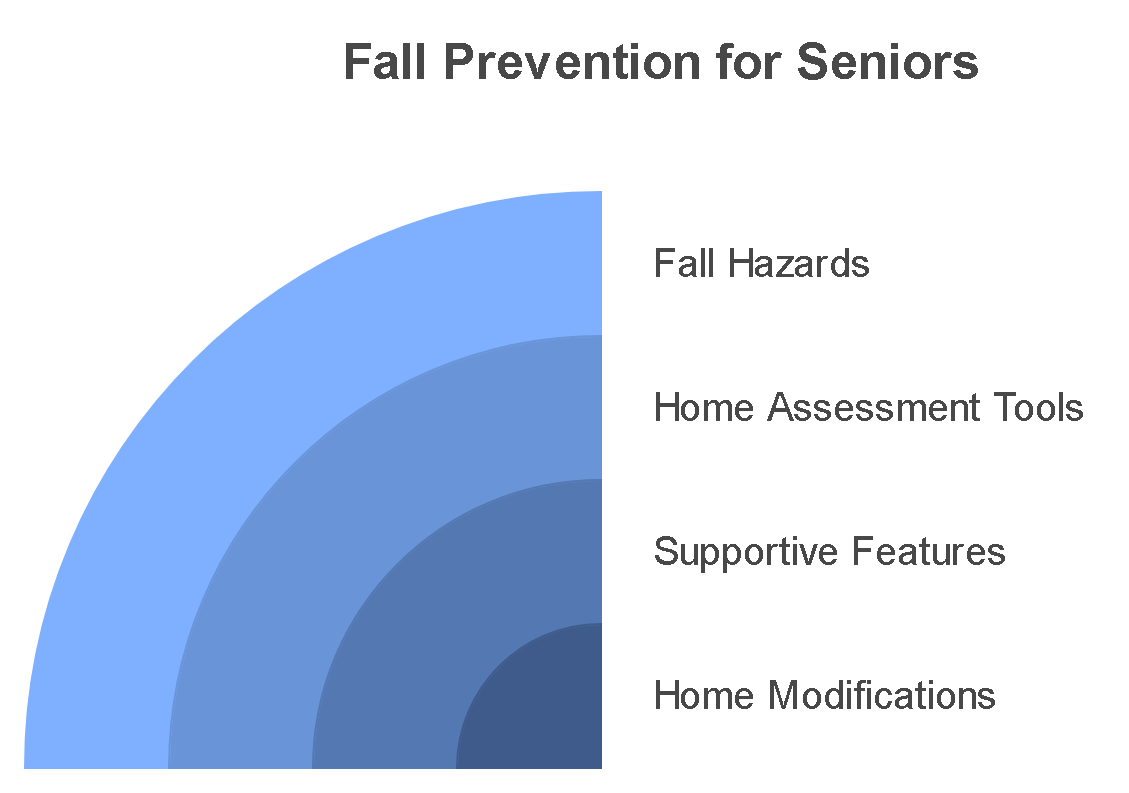
Now that we’ve assessed general home hazards, it’s time to focus on making bathrooms safer for seniors. Wet surfaces and limited space make bathrooms particularly risky. Installing grab bars near toilets, tubs, and showers is crucial for providing essential support and reducing the likelihood of falls. These bars are vital for seniors who need extra stability when moving around.
Non-slip mats or strips in the bathtub and on the bathroom floor can prevent accidental slips on wet surfaces, making the bathroom a safer place. Adequate lighting is also key to bathroom safety. Bright, evenly distributed lights in the bathroom can make a big difference. Night lights or automatic lights can be especially helpful for nighttime visits, providing clear visibility and preventing accidents.
It’s also important to maintain a clear path to all bathroom fixtures, eliminating any tripping hazards. This means keeping the floor free from clutter and ensuring that cabinet doors and drawers are always closed when not in use. By focusing on these details, we can greatly improve bathroom safety and create a more secure environment for our seniors.
Improving Bedroom Safety
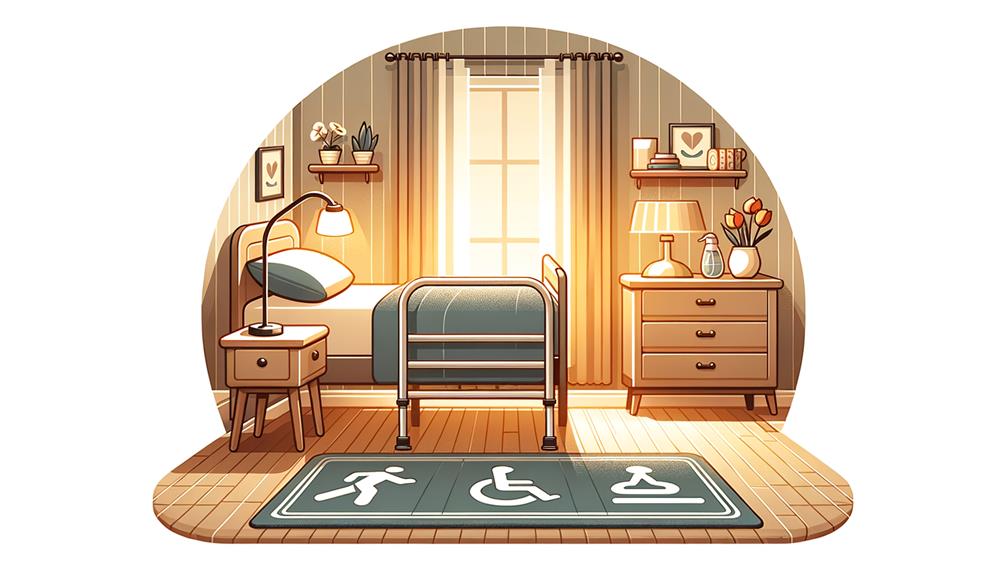
Let’s focus on making our bedrooms safer by tackling two key areas: lighting and clutter. A well-lit pathway is crucial, and we can achieve this by using automatic night-lights and keeping a charged flashlight nearby. Additionally, maintaining a clutter-free sleeping area helps prevent tripping hazards and promotes a safer environment.
Bedside Lighting Solutions
Proper bedside lighting is crucial for enhancing safety and reducing the risk of falls for seniors. A well-lit bedroom greatly improves visibility, which is especially important for older adults with vision impairments. Installing automatic night lights is an effective solution, as they provide gentle illumination that activates in low light, guiding seniors safely during nighttime trips to the bathroom.
In addition to automatic night lights, keeping a charged flashlight within easy reach is vital in case of a power outage or sudden need. This ensures seniors can quickly access a reliable light source.
A clear path to and from the bed is also important, reducing tripping hazards. Installing grab bars or handrails near the bed provides stability and support for getting in and out of bed safely.
Decluttering the Sleeping Area
A clutter-free sleeping area is crucial for seniors’ safety. By arranging the bedroom to allow a direct path in and out, we ensure easy access to the bed and bathroom, reducing the risk of accidents. Keeping the sleeping area free from unnecessary items greatly reduces tripping hazards, promoting a safe environment for rest and mobility.
Installing automatic night-lights along pathways can help seniors navigate safely in the dark. Having a charged flashlight near the bed also provides quick access to light during power outages.
Adding bed rails or grab bars can offer seniors added support when getting in and out of bed, reducing the likelihood of falls. These simple adjustments can make a significant difference in creating a secure and clutter-free sleeping area.
Securing Stairways and Hallways
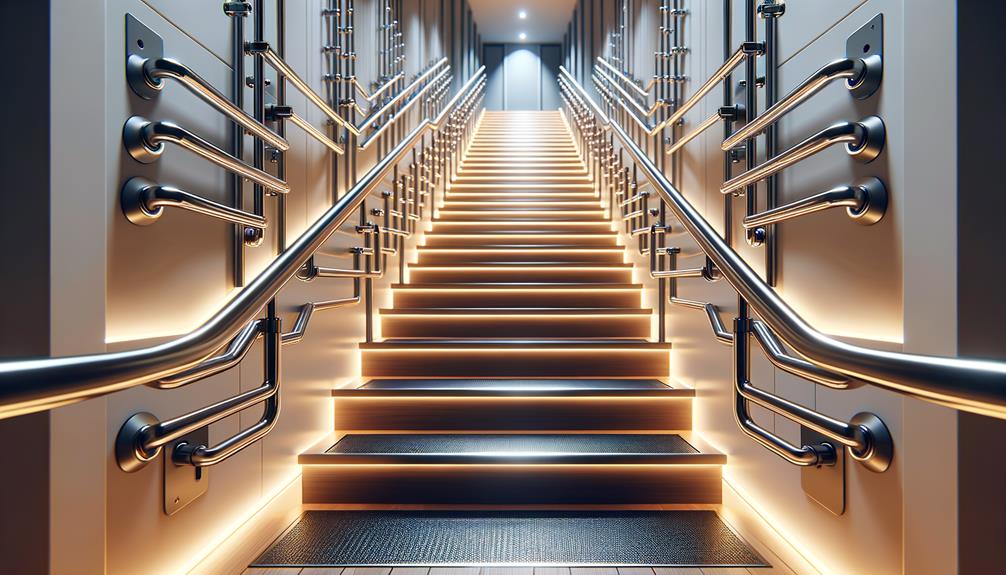
Ensuring stairways and hallways are secure is vital for minimizing fall risks and enhancing overall safety for seniors. Installing sturdy handrails on both sides of the stairs is a must. These handrails provide crucial support and stability, reducing the likelihood of falls. It’s crucial to encourage seniors to grasp the handrails whenever they navigate the stairs.
Good lighting in these areas is also crucial. Ensure that stairways have adequate lighting, with switches at both the top and bottom of the stairs. This helps improve visibility and prevents tripping hazards.
Keeping walking areas tidy and clutter-free is critical. By removing obstacles, you create a clear path for safe movement. Additionally, securing carpets and using no-slip strips on floors can greatly reduce the risk of slipping accidents in stairways and hallways.
Optimizing Living Areas
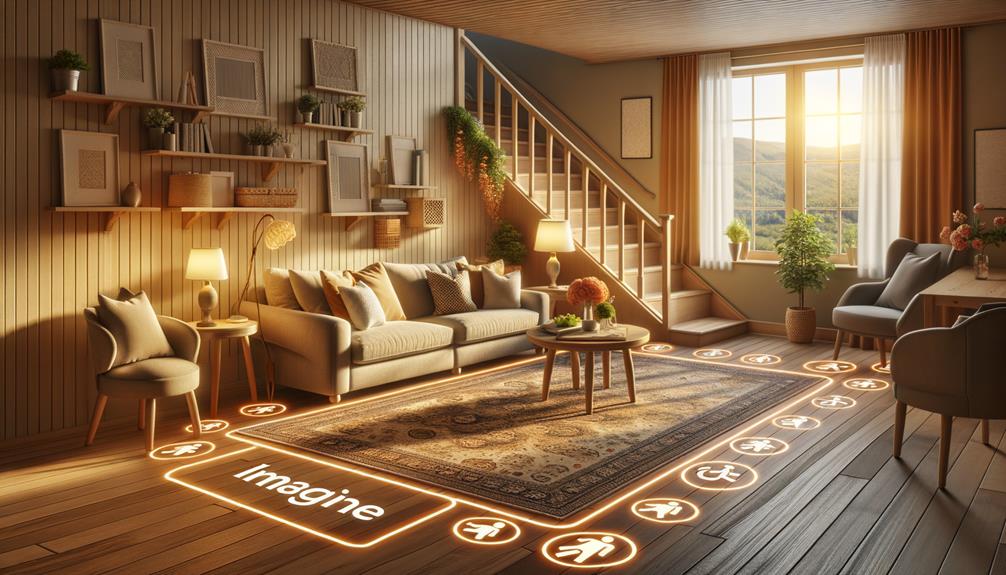
Optimizing living areas for seniors involves arranging furniture for easy navigation, integrating safety features, and ensuring essential items are within reach. To promote fall prevention and enhance home safety, various aspects of living area optimization must be considered.
First, bedrooms should be arranged to allow easy access and use. Installing night-lights and keeping emergency flashlights handy can provide visibility and quick response in case of an emergency. In bathrooms, installing grab bars, non-slip mats, and ensuring adequate lighting can greatly help prevent falls.
Kitchen organization is also crucial. Storing items within reach and using non-skid surfaces can make everyday tasks safer. Securing stairways with handrails, proper lighting, and clear step markings will improve visibility and prevent accidents. Outdoor pathways should be improved with sturdy handrails, proper lighting, and clear, clutter-free paths to ensure safe mobility.
To prioritize fall prevention, consider the following steps:
- Install night-lights to guide safe nighttime navigation.
- Use grab bars and non-slip mats in bathrooms.
- Store kitchen items within easy reach and use non-skid surfaces.
- Secure stairs with handrails and proper lighting.
- Enhance outdoor pathways with sturdy handrails and clear lighting.
Utilizing Assistive Devices
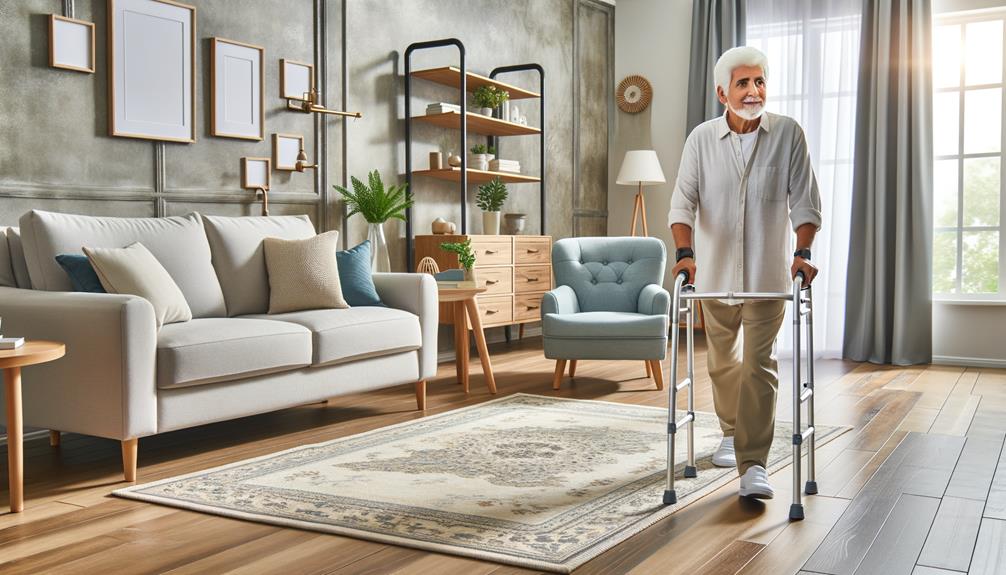
Why not consider assistive devices to enhance safety and independence for seniors? These devices address specific concerns and can be easily incorporated into daily routines. For instance, installing grab bars in the bathroom provides critical support for seniors when entering and exiting the shower. Combining grab bars with shower chairs and raised toilet seats ensures safety and comfort, reducing the risk of falls.
Handrails along stairs and ramps offer essential stability, making it easier for seniors to navigate different levels of their homes. Automatic night lights illuminate pathways, reducing trip hazards in the dark. In wet areas like bathrooms, non-slip mats are a simple yet effective solution to prevent slips.
Sturdy footwear with good grip is also crucial, enhancing balance and stability, and preventing falls both indoors and outdoors. By incorporating these assistive devices into our loved ones’ homes, we create a safer environment that promotes independence and peace of mind. By making thoughtful modifications, we prioritize their safety and well-being.
Staying Physically Active
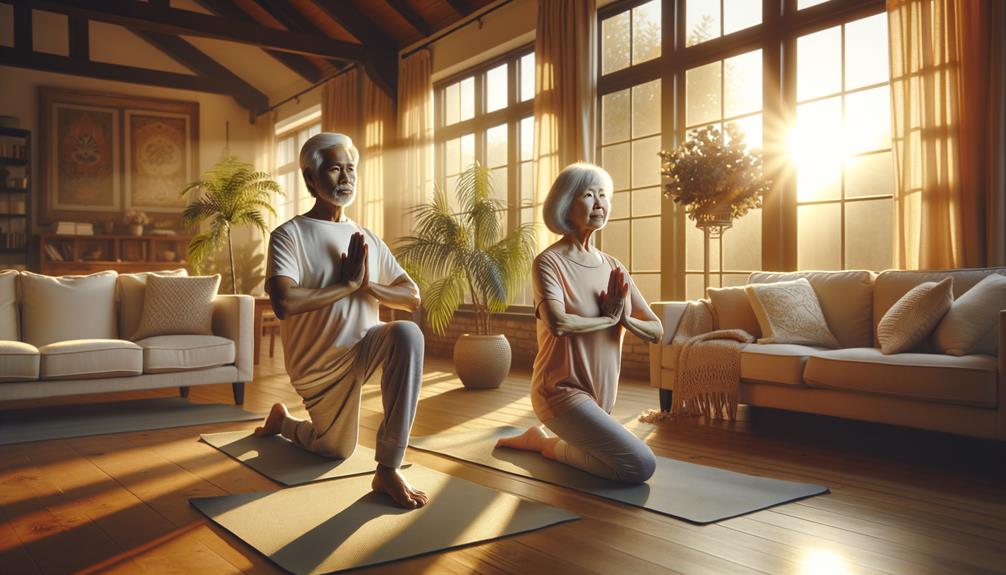
Staying Physically Active
Keeping seniors physically active is crucial for maintaining their strength, balance, and overall well-being. Engaging in physical activities like walking, water workouts, or tai chi can greatly improve strength, coordination, and flexibility. These activities are vital in our efforts to prevent falls, a common and serious concern for seniors.
Unmonitored or inappropriate exercises can pose risks, so it’s essential to get approval and guidance from healthcare professionals. Customized exercise programs designed by physical therapists can address individual needs, ensuring that seniors engage in activities that are both safe and effective. Programs like tai chi, known for enhancing balance and reducing falls, are particularly beneficial.
Regular physical activity has many benefits for seniors:
- Building muscle strength helps maintain mobility and independence.
- Improving balance and coordination significantly reduces the risk of falls.
- Increasing flexibility makes daily movements easier.
- Socializing during group exercise programs boosts mental health.
- Overall well-being is positively impacted, leading to a higher quality of life.
Frequently Asked Questions
How Can Elderly Prevent Falls at Home?
Seniors can prevent falls at home by identifying and addressing potential hazards. This includes installing grab bars and non-slip mats, clearing pathways of clutter, wearing appropriate footwear, ensuring adequate lighting, and regularly reviewing medications with healthcare providers to minimize side effects that may contribute to dizziness or instability.
What Is a Home Fall Prevention Checklist for Older Adults?
Our home fall prevention checklist for older adults covers essential steps to create a safer living space. We evaluate fall hazards, install grab bars, non-slip mats, and good lighting to reduce tripping risks. Securing carpets, clearing pathways, and arranging furniture safely also help prevent accidents. Additionally, we ensure handrails are installed and essential items are easily accessible.
What Are the Home Safety Modifications to Reduce Injuries From Falls?
To reduce the risk of injuries from falls in homes, it’s crucial to make some simple modifications. Installing grab bars in bathrooms, using non-slip mats, storing items within easy reach, adding handrails on stairs, and ensuring proper lighting can greatly reduce the risk of falls. These simple changes can make a big difference in home safety.
How to Safety Proof a Home for the Elderly?
Transforming our homes into safe havens for our elderly loved ones is crucial. By installing grab bars, non-slip mats, and night-lights, clearing pathways, and ensuring proper lighting and handrails on stairs, every detail contributes to their safety and well-being.
Further Resources
For further guidance on fall prevention and home safety modifications for seniors, visit the Centers for Disease Control and Prevention (CDC) Fall Prevention Resources.

